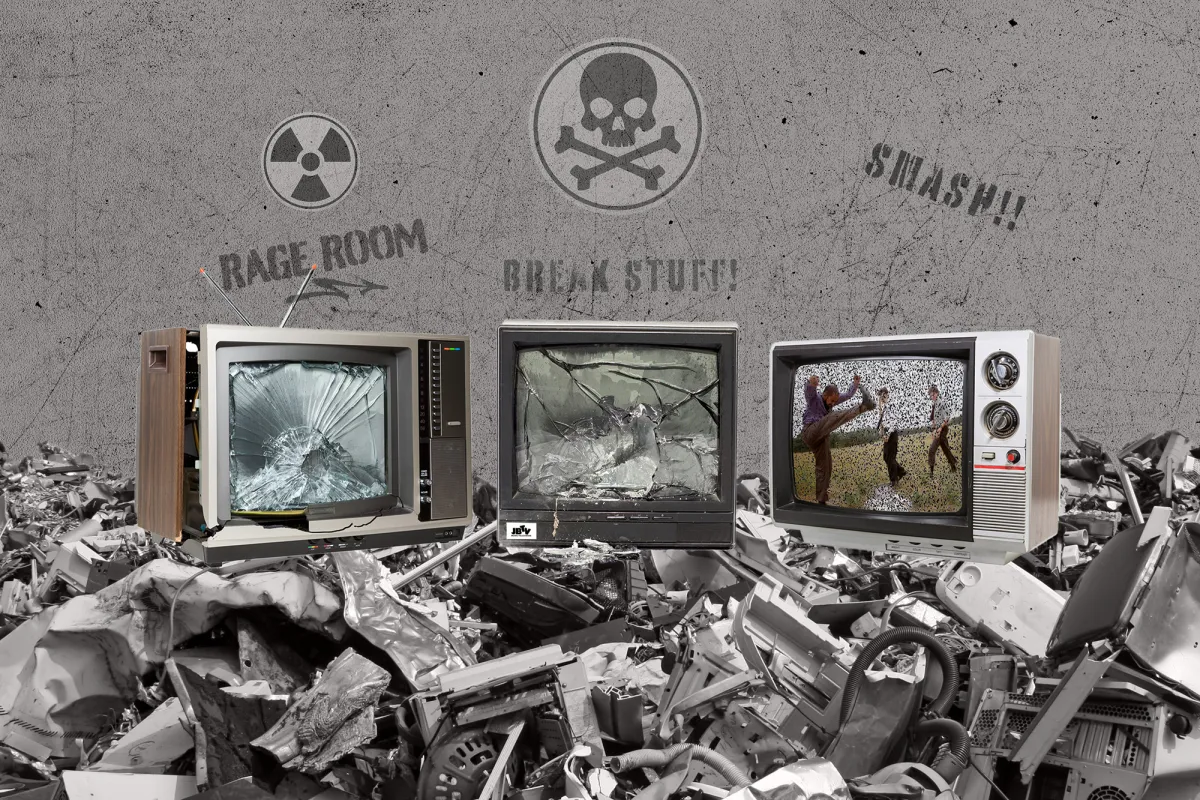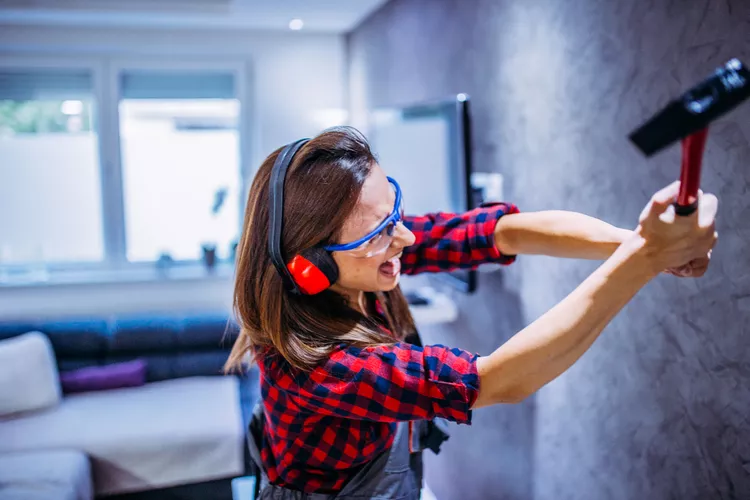Introduction: The Appeal of Destruction Therapy
Life is stressful, and sometimes, we all feel the urge to break something. That’s where rage rooms—also known as smash rooms or anger rooms—come in. These spaces let people release frustration by smashing objects in a controlled environment. But why is this trend gaining popularity?
As stress levels rise, people seek alternative stress relief methods beyond traditional therapy or exercise. The thrill of smashing things offers an adrenaline rush, providing both physical and emotional release. But do rage rooms help with anger management, or is it just temporary relief? Let’s dive into the psychology and reality of this experience.
The Psychological Debate: Do Rage Rooms Actually Work?
Many people visit rage rooms hoping to find relief from stress, frustration, or anger. The idea is simple—smashing objects provides an emotional release, helping people feel lighter and more relaxed. Some believe this activity mimics destruction therapy, a form of stress relief where physical action helps process emotions. The sudden adrenaline rush and physical activity can make people feel better in the moment. But does it truly help long-term?
Psychologists have mixed opinions. Some argue that venting anger through destruction might actually reinforce aggressive behavior rather than reduce it. Others suggest that while rage rooms offer a quick fix, they don’t address deeper emotional issues. Instead, combining smash therapy with anger management techniques or stress management activities—like mindfulness or exercise—may be more effective. While rage rooms can be fun, they shouldn’t replace healthy coping mechanisms for handling emotions.
What Happens Inside a Rage Room?
A rage room experience is simple yet thrilling. When you arrive, you’re given protective gear, including a helmet, gloves, and a jumpsuit, to keep you safe. Then, you choose your weapons—a baseball bat, hammer, or crowbar—to smash a variety of objects. Common items include glass bottles, old printers, TVs, and furniture, all set up in a controlled space. Many rage rooms even let you pick a playlist, so you can break things to the sound of your favorite music.
Each session lasts about 15–30 minutes, depending on the package you choose. Some rage rooms have themed experiences, like an office setting, where you can destroy desks and computers, or a home setup, with plates and furniture. After the session, many people describe feeling relieved and energized, as the physical activity releases built-up stress. While it’s a great alternative stress relief method, it’s important to remember that it’s only a temporary fix and should be combined with other stress management techniques for long-term benefits.

The Business and Economics of Rage Rooms
The rage room industry has grown rapidly as more people seek unique ways to relieve stress. What started as a niche idea has turned into a profitable business model, with rage rooms popping up in cities worldwide. The appeal is clear—people are willing to pay for a safe space where they can vent anger, smash objects, and enjoy a one-of-a-kind stress relief experience. Business owners benefit from low-cost inventory, as many of the items used—like old furniture and electronics—are donated or recycled.
The demand for rage rooms is fueled by young adults, professionals, and even companies using them for corporate team-building sessions. Some businesses offer themed experiences, such as relationship break-up rage rooms or customized destruction setups. The cost of a session varies but typically ranges from $25 to $100, depending on the package and location. With growing awareness of alternative stress relief methods, the rage room business is expected to keep expanding, offering creative ways for people to release tension in a controlled environment.
The Ethical and Environmental Impact of Rage Rooms
While rage rooms provide a fun and unique way to relieve stress, some people question their ethical impact. Critics argue that encouraging destruction may reinforce negative behaviors rather than promote healthy stress management activities. There’s also concern that regularly venting anger through smashing could make aggressive reactions feel more natural over time. On the other hand, supporters say that rage rooms offer a safe space to release emotions without harming others, making them a better option than suppressing frustration or directing anger toward people.
Another big concern is the environmental impact of rage rooms. With so many objects being smashed daily, what happens to all that waste? Many rage rooms try to be eco-friendly by using recycled materials and partnering with scrap yards to dispose of broken items responsibly. Some businesses even use biodegradable objects or allow customers to bring in personal items to destroy, reducing unnecessary waste. While rage rooms can be a great alternative stress relief method, it’s important for businesses to adopt sustainable practices to minimize their environmental footprint.

Rage Room Alternatives: What Works Better?
While rage rooms provide an exciting way to release stress, they aren’t the only option. Many experts recommend physical activities like running, boxing, or yoga as healthier long-term solutions for stress relief. Exercise helps release built-up tension while also improving overall well-being. Other anger management techniques, such as deep breathing, meditation, and therapy, can help people process emotions in a more structured way. These methods may not provide the same immediate satisfaction as smashing objects, but they are often more effective in managing stress over time.
For those who enjoy creative outlets, activities like art therapy, writing, or playing music can also serve as powerful alternatives. Expressing emotions through painting or journaling allows people to process anger in a constructive way. Some find relief through sound therapy, like drumming or listening to calming music. While rage rooms offer an instant adrenaline rush, combining them with other stress management activities can lead to better emotional control and long-term mental health benefits.
Rage Room Stories: Real-Life Experiences
Many people walk into a rage room expecting just a fun activity, but their experiences often go deeper. Some describe feeling an unexpected emotional release, with laughter quickly turning into tears as they realize they were holding in more stress than they thought. Others say that smashing objects gave them a sense of control and empowerment, especially after tough life events like breakups or job losses. For some, it’s not just about anger management—it’s about letting go of frustration in a way they never could before.
On the other hand, not everyone finds rage rooms effective. Some visitors leave feeling more frustrated than before, realizing that smashing things doesn’t solve deeper problems. Psychologists suggest that while these experiences can provide a short-term adrenaline rush, they should be paired with healthy coping mechanisms like therapy, exercise, or meditation for long-term benefits. Still, many rage room visitors agree on one thing—it’s a unique and unforgettable way to blow off steam.

Conclusion: Should You Try a Rage Room?
Rage rooms offer a fun, high-energy way to release stress and experience an instant adrenaline rush. Smashing objects in a controlled environment can feel empowering, especially for those dealing with frustration or anger. Many people leave feeling lighter, more relaxed, and even entertained. Whether you’re looking for a unique activity, an alternative stress relief method, or just a new experience, visiting a rage room can be worth trying.
However, it’s important to remember that rage rooms are a temporary fix, not a long-term anger management solution. While they can help with emotional release, they don’t address the root causes of stress. For better mental well-being, it’s best to combine them with other healthy coping strategies like exercise, therapy, or mindfulness. If you’re curious, why not give it a shot? Just remember to smash responsibly!
FAQs About Rage Rooms
1. What should I wear to a rage room?
Most rage rooms provide protective gear, but it’s best to wear closed-toe shoes, comfortable clothing, and avoid anything loose that could get caught while swinging objects. Safety is a priority, so following the dress code ensures a better experience.
2. Can anyone go to a rage room?
Most rage rooms have an age requirement, typically 16 or 18 years old, with parental consent sometimes needed for younger participants. Some locations also have weight and health restrictions for safety reasons, so it’s best to check in advance.
3. What items can I smash in a rage room?
You can smash a variety of items, including glass bottles, old TVs, plates, furniture, and electronics. Some rage rooms allow you to bring personal items (like an ex’s gift!) for an extra personal touch.
4. How long does a rage room session last?
A standard session lasts between 15 to 30 minutes, depending on the package. Some places offer group sessions or extended time for special events.
5. Can rage rooms help with mental health?
Rage rooms can provide temporary relief by allowing you to physically release frustration, but they are not a replacement for therapy or professional help. For long-term stress management, combining them with exercise, mindfulness, or counseling is recommended.


